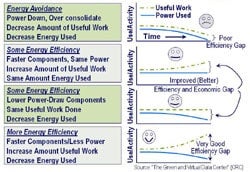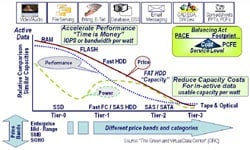There is a lot of focus on energy avoidance these days, as it is relatively easy to understand and implement. Turning off the lights, turning off devices when they are not in use, and enabling low-power, energy-savings or Energy Star modes are all means of saving or reducing energy consumption, emissions and energy bills.
There are a number of easy candidates for powering down when not in use, including desktop workstations, PCs, laptops, video monitors and printers. Turning lights off or implementing motion detectors to turn lights off automatically, and turning off or enabling energy-saving modes on general-purpose and consumer products also offer a significant benefit.
Figure 1 below shows four basic approaches to energy efficiency. One approach is to avoid energy usage, similar to following a rationing model, but this approach will affect the amount of work that can be accomplished. Another approach is to do more work using the same amount of energy, boosting energy efficiency, or doing the same work using less energy.
 |
| Figure 1: The Many Faces of Energy Efficiency (Source: “The Green and Virtual Data Center” (CRC) |
The energy efficiency gap is the difference between the amount of work accomplished or information stored in a given footprint and the energy consumed. The bigger the energy efficiency gap, the better, as seen in the fourth scenario: doing more work or storing more information in a smaller footprint while using less energy.
Given the shared nature of data center resources, along with intersystem dependencies, not all resources can be powered off completely. Some forms of storage devices can be powered off when they are not in use, such as offline storage devices or mediums for backup and archiving. Technologies such as magnetic tape or removable hard disk drives that do not need power when they are not in use can be used for storing inactive and dormant data.
Avoiding energy use can be part of an approach for addressing power, cooling, floor space and environmental (PCFE) challenges, particularly for servers, storage and networks that do not need to be used or accessible at all times. However, not all applications, data or workloads can be consolidated or powered down because of performance, availability, capacity, security, compatibility, politics, financial and other reasons.
Aligning Green IT with Service Demands
For those applications, servers, storage and I/O networks, the trick is to support those in a more efficient and effective means. Simply put, when work needs to be done or information needs to be stored or retrieved or data moved, it should be done so in the most energy-efficient manner aligned with a given level of service.
Technology alignment (see Figure 2 below) — that is, aligning the applicable type of storage or server resource and devices to the task at hand to meet application service requirements — is essential to achieving an optimized and efficient IT environment. For example, for very I/O-intensive active data as shown in Figure 2, leveraging high-performance SSD (flash or RAM) Tier-0 storage, or for high I/O active data, tier-1 fast 15.5K SASand Fibre Channel storage-based systems, would be applicable.
For active and online data, that’s where energy efficiency in the form of fast drives, such as SSD or 15.5K or 10K FC and SAS energy-efficient disks, and their associated storage systems come into play. The focus for active data and storage systems should be around more useful work per unit of energy consumed in a given footprint. For example, more IOPS per watt, more transactions per watt, more bandwidth or video streams per watt, more files or e-mails processed per watt.
 |
| Figure 2: Tiered Storage: Balancing Performance, Availability, Capacity and Energy to QoS |
For low-performance, low activity applications where the focus is around storing as much data as possible at the lowest cost, including disk-to-disk backup, slower, high-capacity SATA-based storage systems are the fit (lower right in Figure 2). For long-term bulk storage to meet archiving, data retention or other retention needs as well as storing large weekly or monthly full backups, tape is the ticket, with the best combination of performance, availability, capacity and energy efficiency per footprint.
General approaches to boost energy efficiency include:
- Do more work using the same or less amount of power and cooling
- Leverage faster processors and controllers that use the same or less power
- Apply the appropriate RAID level for application and data QoS requirements
- Consolidate slower storage or servers to faster, more energy-efficient solutions
- Use faster disk drives with a capacity boost and that draw less power
- Upgrade to newer, faster, denser, more energy-efficient technologies
- Look beyond capacity utilization; keep response time and availability in mind
- Leverage IPM, AVS and other modes to vary performance and energy usage
- Manage data both locally and remotely; gain control and insight before moving problems
- Leverage a data footprint reduction strategy across all data and storage tiers
- Utilize multiple data footprint techniques, including archive, compression and deduplication
- Reduce data footprint impact, enabling higher densities of stored online data
Find a balance between energy avoidance and energy efficiency, consolidation and business enablement for sustainably, hardware and software, best practices including policy and procedures, as well as leveraging available financial rebates and incentives. Addressing green and PCFE issues is a process; there is no one single solution or magic formula. Rather, a combination of technologies, techniques and best practices to address various issues and requirements is needed.
Some technologies and techniques include data management, archiving (including for non-compliance purposes), compression (online and offline, primary and secondary) as well as dedupe for backups, space-saving snapshots, and effective use of applicable RAID levels. Green washing and green hype may fade away, but PCFE and related issues will not, so addressing them is essential for IT, business growth and economic sustainability in an environmentally friendly manner that enables shifting from talking about green to being green.
Greg Schulz is founder and senior analyst of the StorageIO group and author of “Resilient Storage Networks” (Elsevier) and “The Green and Virtual Data Center” (Auerbach/CRC).
Follow Enterprise Storage Forum on Twitter





